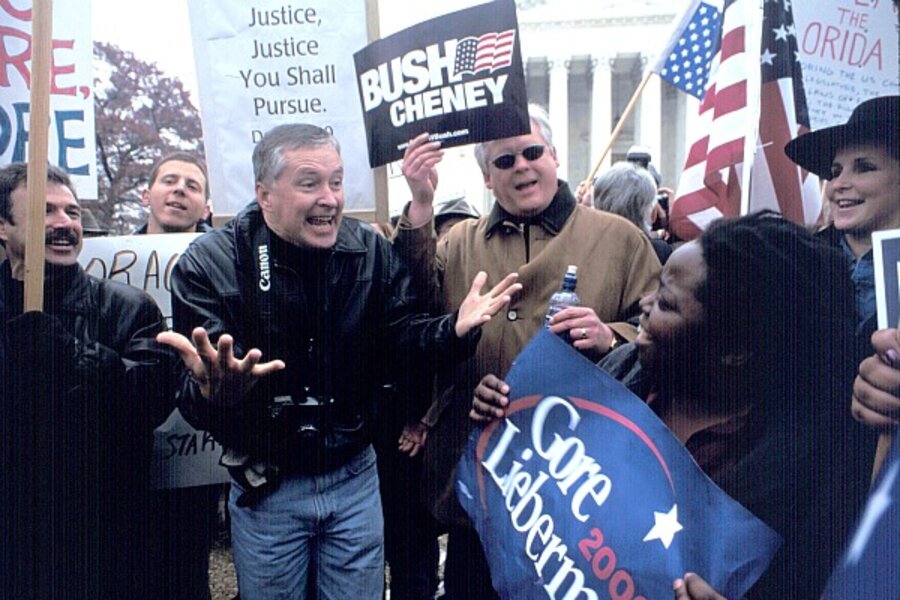Ten years after Bush v. Gore, the fight goes on
Loading...
Some battles in American history and politics never end, at least in terms of passionate public argument. The Civil War. The Vietnam War. Abortion. The Red Sox and the Yankees. Bush v. Gore.
Fortunately, the last one did not come to violent revolution. But the end of the 2000 presidential election – marked Sunday by the 10-year anniversary of the US Supreme Court decision that made George W. Bush the 43rd President of the United States – is just as debatable.
The closest presidential race in US history came down to 537 votes out of 101,455,899 cast. Gore had won the popular vote by more than half a million, but it was the contentious recount in Florida – eventually halted by the Supreme Court – that gave it to Bush in the Electoral College, 271-266.
Thus did “hanging chads,” “dimpled chads,” and “pregnant chads” enter the political lexicon. (One political consultant scooped up those bits of paper ballot detritus and sold them on eBay, bags of 10 for $20.)
Depending on one’s point of view the 5-4 Supreme Court vote cutting off the Florida recount was either as it should have been (given how messed up the balloting and recount procedure had become there) or a political travesty as bad as the 1857 Dred Scott decision denying constitutional protections to slaves of African descent.
That the five justices in the majority vote favoring the Republican nominee all had been elevated to the high court by Republican presidents (four by Ronald Reagan, one by George H. W. Bush) meant the outcome would inevitably be seen in starkly political terms.
And so it is today, despite the admonition of Associate Justice Antonin Scalia (one of the pro-Bush five in 2000) that people should simply “Get over it!” as he’s said on a number of occasions.
“Voters who cast ballots incompetently are not entitled to have election officials toil to divine these voters' intentions,” columnist George Will writes in the Washington Post, referring to the chad debacle. “Al Gore got certain Democratic-dominated canvassing boards to turn their recounts into unfettered speculations and hunches about the intentions of voters who submitted inscrutable ballots.”
“Gore's lawyers persuaded the easily persuadable state Supreme Court – with a majority of Democratic appointees – to rewrite the law [requiring counties to certify their results within seven days],” Will writes.
In an essay in the New Yorker magazine, Jeffrey Toobin sees it differently:
“What made the decision in Bush v. Gore so startling was that it was the work of Justices who were considered, to greater or lesser extents, judicial conservatives,” writes Toobin, a lawyer and legal analyst for CNN. “[But] the Court stopped the recount even before it was completed, and before the Florida courts had a chance to iron out any problems – a classic example of judicial activism, not judicial restraint, by the majority.”
And the result, Toobin continues, is that the high court – headed by Bush-appointed Chief Justice John Roberts, who worked on Bush’s behalf in the Florida recount – has continued this kind of conservative activism, marked by its “willingness, even its eagerness, to overturn the work of legislatures.”
For political junkies who appreciate the ironic and the fanciful, New York magazine has “Memories of the Gore Administration.” Written by “five (sometime) novelists” – Kurt Anderson, Kevin Baker, Glenn Beck, Jane Smiley, and Walter Kirn – it’s an imaginary look at the last ten years as if the 2000 election had gone the other way.
In this fictitious look back, 9/11 still happened (and Flight 93 did hit the White House, although Gore survived), and so did Katrina. (As FEMA director, Robert Gibbs does “a heckuva job.”) The US invades Afghanistan, but not Iraq. Hillary Clinton becomes vice president, replacing Joe Lieberman, who had resigned in protest over failure to be more confrontational with Iraq and Iran. (This was after Hillary Clinton had divorced Bill Clinton, who married Carla Bruni.) In the 2008 presidential election, Mitt Romney beats John Edwards, whose running mate is “all-around man-of-the-future Barack Obama.” Romney appoints Sarah Palin as Secretary of the Interior. And so on.
In this case, as it’s turned out, truth may indeed be stranger than fiction.
Footnote one: The Green Party will disagree, but it can be argued that Ralph Nader did to Gore what Ross Perot did to George H.W. Bush in 1992, that is, cost him the election. In Florida, Nader won 97,000 votes – many times more than Gore needed to win the state and the presidency without the hassle of a recount. But like the election itself, that debate will never be settled.
Footnote two: Bush v. Gore featured opposing attorneys who gained rock star status: David Boies for Gore and Theodore Olson for Bush. Today, Boies and Olson are working together on behalf of gay rights to overturn California’s Proposition 8 banning same-sex marriage.


